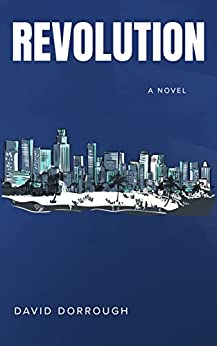Los Angeles, California provides the setting for REVOLUTION, a story that follows the lives of several characters who may loosely represent a cross section of the city’s population. The character list is long. Primary ones include Bill and Yvonne, who have two children, take frequent walks to reach their goal of 10,000 steps per day, and experience some marital issues. Yvonne’s coworker Amy yearns to know the identity of her birth parents. Irene wants to launch a new virtual reality product that provides “the soundtrack to your life.” Juice is a medical doctor who seeks revenge on a former high school classmate who she believes stole her necklace back in the day. Gary is determined to run the marathon of all marathons in North Virginia. And Matt believes that old-time movie actress Marion Davies buried a treasure chest on Santa Monica beach and he is going to find it.
REVOLUTION begins and ends with Bill and Yvonne taking a walk—two of the countless number of walks they take that are described in great detail in which readers learn all about the neighborhood architecture, the people and animals they see, what type of cars drive by, and even the number of dog poop sightings. Everything is described in great detail in this book—the interior of each character’s home, restaurants they frequent, meals they eat, office meetings they attend, traffic problems they encounter, and scenery they see during long car rides. In Chapter 25, Bill and Yvonne go to the grocery store, and for the next several pages, the inside of the grocery store is described ad nauseam—the cereal aisle, canned vegetable shelves, the Employee Only door, the beverage department, dairy products placed in the coolers, produce, and the checkout line.
Some aspects of the book could be interesting if fully fledged out—Amy’s search for her birth parents, Irene’s virtual reality product idea, Matt’s journey to find the buried treasure, Gary’s quest to run the Virginia marathon. However, none of these stories has a strong enough beginning, middle, or ending to make for a compelling read. Many unnecessary characterizations clutter the narrative. For example, in Chapter 2, the character Oleanna is introduced. She is a server in a restaurant where Amy and several co-workers gather after work one day. When she was eighteen, Oleanna had moved to from Oklahoma to California to fulfill her dream to one day work in a top-tier L.A. restaurant. She currently struggles financially and works part-time as an actress to help make ends meet. The back story on this character serves no purpose in the book but to fill space.
This novel follows none of the widely-accepted rules for writing fiction. There is no central plot, narrative arc, or satisfying ending. The characters are not fully developed and blend in with one another. The “show, don’t tell” rule is frequently violated. The chapters contain mostly back story, narrative exposition, and description instead of action, internal thoughts, and meaningful dialogue. Smooth transitions between scenes are often missing. Several sub-plots are introduced but not satisfactorily completed. The amount of extraneous information presented outweighs engaging content. Perhaps the most dissatisfying aspect of REVOLUTION is the lack of a central plot and narrative arc, arguably the backbone for good storytelling, without which typically results in readers not finishing the book.
On the Acknowledgements page, Dorrough writes that “everything about this book that is stupid, boring, offensive, incomprehensible, or pointless is entirely his own doing.” If these writing attributes are what the author intended, he met his goal. With 700+ printed pages, Dorrough obviously invested considerable time in crafting REVOLUTION. Whether there are readers who will find it interesting and the book is marketable are questionable.
David Dorrough’s REVOLUTION is rich in the number of characters and laced with witty prose but lacks the essential elements (a central plot, well developed characters, etc) of a well-written novel.
~Florence Osmund for IndieReader

